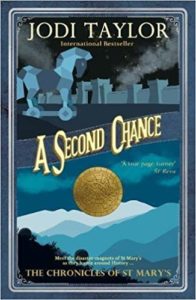A Second Chance, the third book in Jodi Taylor’s series about the time-traveling historians of St Mary’s Institute, shows signs of settling in for a set of tales that is going to continue. Taylor dials the pace back just a bit from madcap to merely rapid, she’s willing to develop the settings the historians visit a bit more, and she introduces some new characters who look likely to become recurring. Not only that, Taylor allows her first-person narrator, Dr Madeleine Maxwell (Max, to nearly everyone), to admit that they travel in time and not merely “investigate major historical events in contemporary time” as she had previously insisted.
Having promised at the end of A Symphony of Echoes that the historians would be off to the Trojan War in the next book, Taylor opens with a prologue that puts Max in terrible danger — separated from the other historians after the fall of Troy, in a mass of captive women the victorious Greeks are winnowing, deciding who to carry off on a ship into slavery and who to put to the sword on the spot. Then Taylor rolls back the action to a more light-hearted time, with historians having painted themselves blue for reasons that remain obscure, and St Mary’s doing their director a favor by taking an old friend of his on a pre-retirement jaunt to see Sir Isaac Newton during his Cambridge days. Things of course go sideways as soon as the friend reaches out to shake Sir Isaac’s hand. Professor Penrose turns out to be sprightly for his age, have a cool head when being chased by a mob, and a knack for helping Max in unexpected ways. This is his first appearance in the series, but I bet it won’t be his last.
Troy, however, takes up most of the book. For the first time, Taylor shows St Mary’s undertaking a major mission. The historians bracket the years of the war until they have a fairly precise idea of when it happened, then they settle in some years before to get to know the city and understand the civilization before its final conflict. It’s a pleasure seeing them work, and an additional one to have Taylor show Troy in its splendor and its humanity.
“Everything had changed on our second visit. By our calculations, the war was well into its tenth year now and the Trojans were suffering. Long years cooped up behind their own walls had taken their toll. The arrival of their allies had more than tripled the population. The streets were packed with Lydians, Carians, Phrygians, Lycians, Thracians, and many more, all noisily pushing their way through the crowds and filing every roadside tavern and eating-place.” (p. 131)
They have timed it right and get to see the epic confrontations that Homer describes in The Iliad. Achilles, Paris, Priam, Cassandra, Hector and more are all there. The epic turned out to be right about many things, but some of the most famous aspects of the war didn’t quite happen as described. The historians find themselves in the unusual position of not actually knowing what is going to happen next, even in general terms. It’s about that time that Max winds up in a bad way: alone, captive, soon to be sorted by Greek soldiers who take her for a Trojan woman. Worse, Cassandra has prophesied bad things for Max’s future. Unlike anyone else in Troy, Max believes her.
She escapes Troy, of course, because it’s that kind of a book, but the choices she makes and the actions that allow her to escape have ramifications up and down the timeline, because it’s that kind of a book, too.


1 pings
[…] time — “It’s time travel, OK” — and follows closely on the events of A Second Chance. The title of this book refers to the ability of its major antagonists, the Time Police, to follow […]